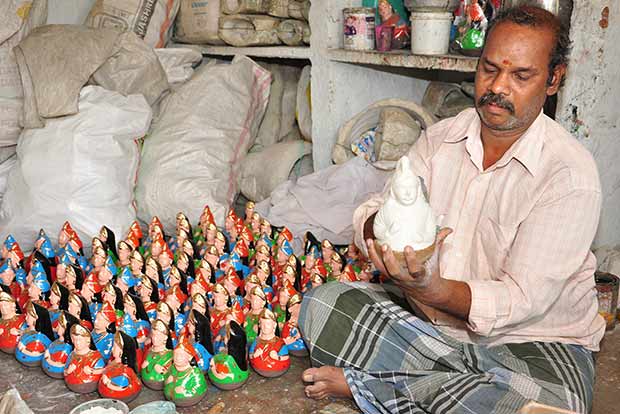Begin typing your search...
Chinese toys halt rocking legacy of traditional Thanjavur dolls
Thanjavur Thalayatti Bommai, the traditional dolls, that used to be a definite feature in the showcase of every household and the Navarathri festival are slowly on the way out owing to the arrival of plastic and China toys and the poor profit.

Chennai
With the patronage for the these ‘rocking dolls’, part of the identity of ancient Thanjavur, dwindling, the artisans, who were involved in their production, have switched to other professions.
Over 100 families that had been creating this attractive model for more than four decades at Mariammankoil village in Thanjavur, have migrated to either agriculture or some other petty jobs. The reason attributed by them is the poor profit for the workmanship they put in.
“Once a profitable and prestigious trade, the profession and the product have lost their charm as people have started opting for cheaper Chinese electronic toys. Due to these reasons the younger generation of the doll makers did not show interest in learning the art and presently, only three families are still continuing with the profession,” S Boopathy (50), a third generation doll maker from Mariammankoil village told DT Next.
Boopathy, who is the sole supplier of the rocking dolls to the Poompuhar showrooms across the state, opined that the declining patronage among the public and the poor profit for artisans have pushed the making of the dolls to the verge of extinction.
“I fear that after my life, the Thanjavur dolls will be treated as antique pieces or become history,” laments Boopathy who has trained his son, who is studying in a college, in making the dolls as part of his efforts to to save the art.
Boopathy’s family used to make around 400 toys per month. During the peak tourist season, the numbers may go up to 500 or 600 pieces per month and each one will be sold between Rs 40 and Rs 50. The profit margin is just Rs 5 to Rs 10 per doll.
“To get the right shape and quality, we have to carefully mix the clay and dry them during a particular period and later paint them with organic dye,” he explains.
There have also been technological changes in making these dolls over the years. “During ancient period, clay alone was used as the raw material for making the thalayatti bommai. Nowadays, we make the bottom portion of the doll with clay to give a strong base and the upper part figuring king or queen with the paper mache or plaster of paris,” said Boopathy who had appealed to the officials to rope in youngsters and train them to save this dying art.
Visit news.dtnext.in to explore our interactive epaper!
Download the DT Next app for more exciting features!
Click here for iOS
Click here for Android
Next Story



